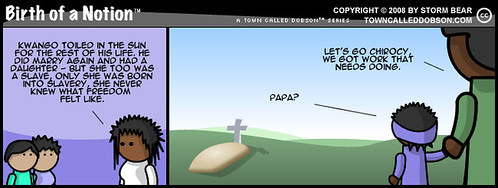Crossposted from Left Toon Lane, Bilerico Project & My Left Wing

click to enlarge
The first record of African slavery in Colonial America occurred in 1619. A Dutch ship, the White Lion, had captured 20 enslaved Africans in a battle with a Spanish ship bound for Mexico. The Dutch ship had been damaged first by the battle and then more severely in a great storm during the late summer when it came ashore at Jamestown. Though the colony was in the middle of a period later known as “The Great Migration” (1618-1623), during which its population grew from 450 to 4,000 residents, extremely high mortality rates from disease, malnutrition, and war with Indians kept the population of able-bodied laborers low. With the Dutch ship being in severe need of repairs and supplies and the colonists being in need of able-bodied workers, the human cargo was traded for food and services.
In addition to African slaves, Europeans, mostly Irish, Scottish, English, and Germans, were brought over in substantial numbers as indentured servants, particularly in the British Thirteen Colonies. Over half of all white immigrants to the English colonies of North America during the 17th and 18th centuries consisted of indentured servants. The white citizens of Jamestown, who had themselves arrived from Britain, decided to treat the first Africans in Virginia as indentured servants. As with European indentured servants, the Africans were freed after a stated period and given the use of land and supplies by their former owners, and at least one African American, Anthony Johnson, eventually became a landowner on the Eastern Shore and a slave-owner himself. The major problem with indentured servants was that in time they would be freed, but were unlikely to become prosperous. The best lands in the tidewater regions were already in the hands of wealthy plantation families by 1650, and the former servants became an underclass. Bacon’s Rebellion showed that the poor laborers and farmers could prove a dangerous element to the wealthy landowners. By switching to pure chattel slavery, new white laborers and small farmers were mostly limited to those who could afford to immigrate and support themselves.
Disclaimer:
When I went to school, we were never taught Black History. We never learned about the Black leaders, the long, agonizing history that brought most Blacks to America. Those atrocities were glossed over in favor of mindlessly boring topics like the X Y Z Affair.
This series of cartoons will review Black history as told from a Black mother to an interracial child. This series will be ugly, course, horrific and truthful. I will mostly abandon the commentary for an article on Black history.
This series is not about Obama or Hillary. I want to you to try to imagine how Black families tell their children of the atrocities their ancestors, all of them, suffered because of the color of their skin. Try to imagine how Black families counsel their children when someone calls them “nigger” for the first time. Can you imagine the bone crushing emotion that must well up? Can you imagine the agony, frustration and anger?
Can you imagine being the Black preacher who tries to paint a picture of a just God every Sunday? Especially in a country that claims where the notion of racism is a thing of the past, the job is difficult.
These strips may at times be entertaining and sometimes they may not – mostly not.
I don’t want you to laugh so hard you cry, I want you to cry so hard you do something about it.


